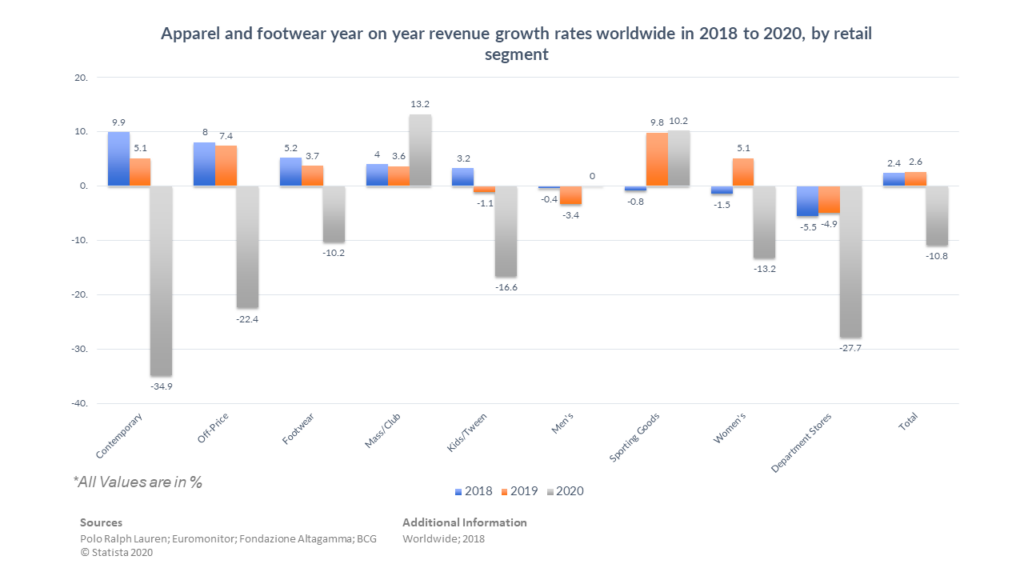In 2020, the global apparel and footwear market revenue was about $160.61 billion. Due to the impact of COVID-19, the market has been groundbreaking and shocking for businesses. Many businesses have been negatively impacted by the outbreak globally. Compared to the year-on-year growth during 2017-2019, the current global market showed a huge decline of 10.6% in 2020.
In 2021, the market is projected to increase from USD 170.94 billion and grow to USD 267.61 billion in 2028 with a CAGR of 6.6% over the forecast period. The sudden increase in CAGR was due to the demand and growth of this market, returning to pre-pandemic levels after the pandemic ended. Especially shopping in brick and mortar stores is back after Covid in 2021 and 2022 as CNN tries to explain why.

The market is growing absolutely, as people are progressively interested in the product’s capability to offer sweat-wicking & breathability and enhancement of physical movement. The product assists in safeguarding from extreme weather conditions, improving blood circulation, and injury prevention is helping to increase its utilization.
The increasing growth of the urban population is increasing the consumption of products due to the increasing involvement of people in fitness clothing related activities. For example, data released by the World Bank, in 2019, the global urban population was assessed as reaching 55.714 percent, up from 55.27 percent in 2018.
The outbreak of the Coronavirus has negatively affected the industry across the globe as lockdowns and restrictions made on the number of customer store occupancy have resulted in a reduction in sales.
For example, data released by Business Wire in April 2020 reported that due to the Covid-19 outbreak, Columbia Sportswear Company experienced a 13% decrease in revenue for the first quarter. In addition, late delivery of goods due to taking certain precautions also reduces its sales. In addition, Economic Times data released in February 2021 stated that the pandemic had an impact on reducing global maritime trade by 4.1 percent in 2020.
The Driving Factors
The increasing number of females participating in various sports domains, including football, athletics, basketball, and others, is helping to satisfy the demand. For example, the data published by the Olympic.Org, in 2018, female participation in the Winter Olympic Games in Pyeongchang, South Korea is 41%.
Additionally, the rising number of female sporting events such as the ICC Women’s World Cup, the FIFA Women’s World Cup, the Women’s FIH Hockey World Cup, and others that are specifically designed for women’s involvement has thus led to escalating consumption.
The escalating rise of the health-conscious population surging the number of gymnasium visits in various countries around the world has helped to intensify the need for the product.
On top of that, the rise in popularity of the use of fitness apps in technological devices has led people to take up fitness activities to improve their health to generate traction. For example, the World Economic Forum in September 2020 data declared that in the first half of 2020, fitness apps had witnessed a 50% increase in usage.
Market Insights
First of all, the sports footwear market is getting a boost from the Asia-Pacific as rising health concerns in the region are driving the demand for sports shoes. China and Japan dominated the regional market share, but India, Australia, Indonesia, and South Korea were gaining prominence and contributing to the growth of the sports footwear market in the region. The global apparel and footwear market size is expected to increase by over USD 12 billion between 2017-2022.
Secondly, the growth of e-commerce and m-commerce is the main factor driving the growth of the online footwear market. Factors such as increasing purchasing power parity and internet penetration have led to an increase in the volume of purchases of footwear products through online platforms.
Also, footwear market players also want to reduce fixed capital costs to maintain physical retail stores which encourages them to sell their products through online retail channels. Online sellers also find it easier these days to solve the question for how to source and how to find manufacturers with easier access to suppliers online.
Last but not least, the athletic footwear market is fundamentally driven by increasing awareness of the advantages of living a healthy and physically active lifestyle. Busy work schedules and increasing health problems have forced people to opt for running as a form of exercise.
With increasing levels of participation in sports and fitness activities such as running, hiking, trailing, aerobics, and training, the athletic footwear market in the US is experiencing tremendous growth, especially in the running shoe segment. Most people in the world would like to work out more.
The Future of E-commerce Business
With the rise of e-commerce, more and more people buy everything online. Because it’s flexible and offers a delivery service to your front door.
Due to this, 30.5% of the total revenue 2022 generated by the footwear industry is expected to come from online sales. In comparison, in 2017, the online revenue share of the global shoe industry was 20.5%. By 2025, this number is expected to increase to 36.6%—an impressive 16.1% rise in less than a decade. This gives clothing manufacturers and retailers a great chance to make up the striking market during Covid quickly.




